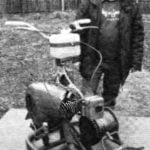In this publication, the speech will focus on the pilot snake. The design is quite simple, but when you create a snake you can master the manufacture technology of the main elements of this aircraft, the methods of debug and tuning, launching and piloting.

Serpent pilot-glider:
1 — frame (pine slats f 8); 2 — bearing surface (synthetic fabric); 3 — fabric closure; 4, 7, 8 — leashes and a harness; 5 — ring of the bridle, 6 — LVL (wood, rail 2.5 x 15)
Design and piloting of snakes differs from classic glider — the frame also consists of a pair of lateral and one Central rack and two rails-cross bars and the bearing surface is a fabric wing-sail.
Snake pilot for the proposed design need round wood (preferably pine) slats with a diameter of 8 mm. If you can not find a ready, similar to the diameter of the rods, try to do them yourself is not too difficult.
First you need to pick up is smooth, without knots and ROE Board 10 mm thick and “dissolve” it with a bow saw or “saws” on a rail cross-section 10 x 10 mm. Then the rail must be rounded with a plane and then calibrate — to pass through the holes in the gauge “Board” made of steel strip with a thickness of about 5 mm, in which the drilled holes with a diameter of 9.2, 8.9, and, of 8.6 and 8.3 and 8.0 mm.

Bearing surface (the sail):
1, 2, 3, 4 — cloth of different colors.
Letters shown: a — axis of the front cross-rail; B — axis of the rear cross rails; C, d, D, E, F — axis connecting joints between the sheets of the sails; And the axis of the side rails; To — axle armor

Central fixation (A) and side (B) slats, and LVL (C)

Frame snake-glider:
1,5 — side docking stations; 2 — side rail L 1200; 3 — bridle ring (steel ring f 20); 4 — leash frenulum (L480); 6 — front docking port; 7, 11 — Central Docking stations; 8 — front cross rail (L 510 ); 9 — Central rail (L 820); 10 — rear cross rail (L 1220); 12 — the Central node, attaching a leash bridle; 13 — leash frenulum (L 600); 14— leash frenulum (560 L)

The formation of pockets under the frame rails:
A — for the side rails; B — for the Central rail. Laderman arranged similarly to the Central pocket

Main docking ports and structural elements of a snake-glider:
1 — ending the side and center frame rails; 2 Central connecting node of the frame of the elastic tube, f 18; 3 — front docking port; 4 — side docking port with a yoke attaching a leash frenulum; 5 — Central node, attaching a leash frenulum; 6— improper attachment of a bridle

Carabiners, swivels and the ring mounts to the sling and leash frenulum

Carabiners used in the system of toe-hooks snake:
1 — steel wire, 2 — sheet steel

The scheme undercut the trailing edge of the sail with the sewing machine

Options cut sails (bearing surface) of the pilot snake

The scheme of joining of panels of the sail with the sewing machine

Scheme of the formation of Central pocket of the sail

The cutting out of panels of the sails with the help of Thermaltake

Experienced smebody easily perform aerobatics group

Chetyrehlistnyj snakes original coloring
![The first exercise in the development and piloting of the snake — swinging (A). Next, you can try to master the angle (B) and]()
The first exercise in the development and piloting of the snake — swinging (A). Next, you can try to master the angle (B) and “horizontal figure eight” (In)

A beautiful exercise in piloting a kite on the waterfront, in the process of completing the wing tip through the surface of the water
After calibration of the slats should be sanded, and when of them will be made of details of the frame, they should be covered with parquet lacquer.
Details of frame and flight of the serpent are joined together by means of elastic connecting elements to make them better polyurethane or rubber tubing inside diameter should be such that they force stretched on the frame rails.
In some elastic couplers will need to make holes — it is best to knock them out with a punch, made of steel tubing, the walls of which are acutely sharpened on the inside. In cutting the hole inside the elastic tube should enter the wooden rod of the appropriate diameter.
With rubber or plastic tubing with an outer diameter of about 18 mm are connected to also cross with Central rail.
Elastic tube will need for attachments to the rails of the frame of the bridle in such detail need to cut out two holes and cut the jumper between them sharpened knife. Themselves strands of the bridle fixed to the rocker, made of duralumin strip with a thickness of 2 mm and inserted when mounting inside of the tube so that the lug of the rocker arm peeking out of the cut in the tube holes. Such rocker arms are introduced in the connecting nodes connecting the side rails with crossbars.
Bearing surface of the pilot snake (also called sailing) is tacked from air-tight fabrics, such as the one that goes to the jackets.
First, you need to draw the pattern — this can be done on a sheet of paper of suitable size; if necessary, a sheet of the desired size, glued from several. The scheme of the bearing surface of the serpent shows the pattern consisting of several mixed fabric panels. However, it is possible to sew the supporting surface of the snake and one or two panels.
When cutting synthetic fabrics is highly recommended to cut not with scissors, and tormaresca as this tool is quite suitable device for burning wood or made in his likeness homemade cutter with nichrome filament, glow by an electric current from Later. In addition to cutting, with the help of this tormaresca in the sail cut also and Windows in the locations of the elastic connecting assemblies and the attachment strands of the bridle.
For cutting the fabric you can also use a regular soldering iron, acutely sharpened its sting is about the same as a conventional screwdriver. Well, in a pinch, you can use a nail with a diameter of 5 — 6 mm, inserted in a wooden handle — heat it in the flame of a gas burner.
If you take advantage of our “patchwork” pattern, then work should begin with sostragivaja separate pieces of fabric in a single panel — you just do not forget to leave allowances for the pockets of the side rails and to roll the fabric along the rear edge of the bearing surface. When sostradanii is best to use the seam type “zigzag” — he does not give outages, and when filled the sails of the air flow can stretch with the fabric. Before sewing you should familiarize yourself with the schemes of lateral and Central pockets, and lackermann. The latter is designed to be installed in their lat — flat strips with a cross section of 2.5 x 10 mm, which is best done of school lines of suitable length.
Build a snake is not particularly difficult. The main thing here is to ensure the symmetry of the apparatus, and primarily the symmetrical setup of the bridle: the length of her leash from node to node should be strictly conforming to our schema size.
First, the side pockets are introduced with appropriate rail, and at the same time they are pulled through the elastic connecting component; similarly inserted into the pocket and a Central rail. Further, all of the slats are connected with the front connecting parts and it is fixed on the sail cloth closure. At the end of the tail part of the reek and Latin are secured by a sewn to the sail of rubber bands.
The first launches of snake it is best to produce together with a mild smooth wind. If the bridle is properly tightened, hovering snake will be sustainable. Machine control is carried out by pulling the right or left arms, it is possible to get a snake to perform as a simple evolution — for example, rocking, and more complex, resembling aerobatics. Some of them in our drawings.
Recommend to read
 TWO CYLINDERS FOR THE FOUR WHEELS
TWO CYLINDERS FOR THE FOUR WHEELS
to Build a simple, unpretentious and reliable car I can say, came from humble circumstances. In the late times of General scarcity, I bought a well-worn "Zaporozhets", which stood more... PLOW WINCH
PLOW WINCH
Ground treatment — the work is physically difficult. To facilitate the farmers-gardeners and used mini tractors and tillers. I thought that it is best for such work fits motoliberty, and...
 Serpent pilot-glider.The material world around us is continuously changing, enriching all new components, including emerging technical sports. Thus, only in the last decades there has been a Windsurfing and hang gliding, it has become habitual flights in motor gliders, in the snow more often there are fans monoskis-snowboard and young admirers skibord learned to fabricate on their skateboards that were unaccustomed to such a spectacle of man’s best just to squint.
Serpent pilot-glider.The material world around us is continuously changing, enriching all new components, including emerging technical sports. Thus, only in the last decades there has been a Windsurfing and hang gliding, it has become habitual flights in motor gliders, in the snow more often there are fans monoskis-snowboard and young admirers skibord learned to fabricate on their skateboards that were unaccustomed to such a spectacle of man’s best just to squint.
